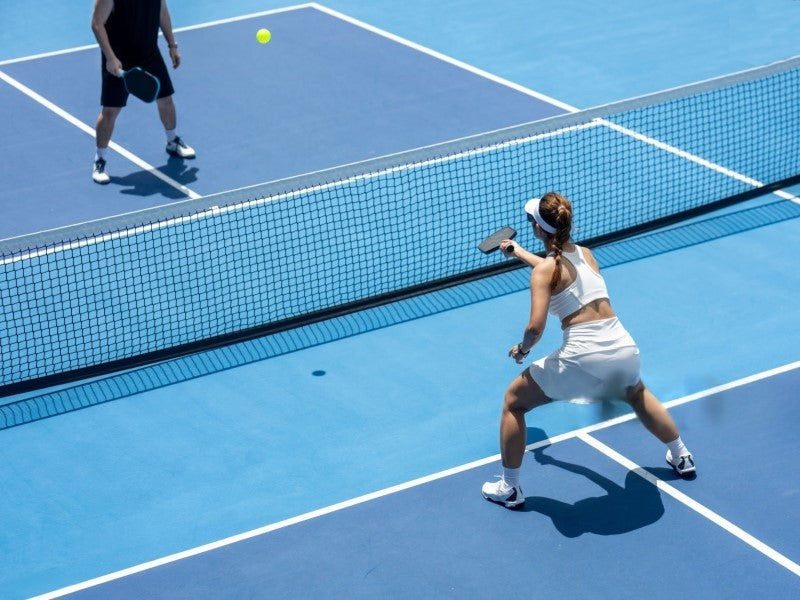Pickleball and tennis may share a few surface similarities, but the courts they’re played on differ significantly. Whether you're a facility manager, recreational player, or homeowner considering installing a court, understanding the nuances between a pickleball court and a tennis court is crucial.
What Is a Pickleball Court?
A pickleball court is a compact, rectangular space measuring 20 feet wide and 44 feet long for both singles and doubles matches. The court features two designated service zones and a 7-foot no-volley region—often referred to as the "kitchen"—positioned on each side of the net.
Key Components:
- Non-volley zone (7 ft from the net)
- Left and right service boxes
- A net 36 inches high at the sidelines and 34 inches in the center
- Hard surfaces like asphalt or concrete, often with an acrylic top layer
What Is a Tennis Court?
A tennis court is significantly larger. The standard dimensions are 78 feet long by 27 feet wide for singles and 36 feet wide for doubles. It features a net that is 42 inches high at the posts and 36 inches in the center.
Key Components:
- Baseline, service boxes, center mark
- Doubles alley (extra width for doubles play)
- High-tension net and sturdy posts
- Surfaces range from clay and grass to synthetic or asphalt

Pickleball Court vs Tennis Court: Size and Layout
|
Feature |
Pickleball Court |
Tennis Court |
|
Total Dimensions |
20 ft x 44 ft |
36 ft x 78 ft |
|
Non-volley Zone (Kitchen) |
Yes (7 ft) |
No |
|
Net Height (Center) |
34 inches |
36 inches |
|
Playing Surface Area |
880 square feet |
2,808 square feet |
|
Players (Doubles) |
2 per team |
2 per team |
The surface area of a tennis court is over three times larger than that of a pickleball court.This size difference is one reason pickleball is easier to learn and less physically demanding for beginners and older adults.
Surface Materials and Maintenance
Both types of courts can be built using similar base materials—most often asphalt or concrete with an acrylic surface layer for traction and weather resistance.
Pickleball:
- Needs minimal space and costs less to maintain.
- Easier to clean due to smaller area.
- Can be built indoors or outdoors.
Tennis:
- Requires more maintenance over time.
- Surface wear is greater due to higher player movement intensity.
- Often needs fencing, ball stops, and lighting.
Gameplay Impact: Court Size and Pace
Pickleball:
- Smaller court equals quicker reflexes and faster rallies.
- Emphasizes strategy, dinking, and net play.
- Ideal for all ages and skill levels.
Tennis:
- Larger court allows for more power-based gameplay.
- Requires higher endurance and mobility.
- Suited for those with more athletic conditioning.
- The court size affects the style of play, pace of the game, and physical demands—making the choice of court type important based on your target audience or usage goals.
Pros and Cons of Pickleball Courts vs Tennis Courts
When choosing between a pickleball court and a tennis court, it helps to understand the specific advantages and disadvantages of each. Below is a breakdown to help you decide which better fits your space, goals, and user base.
Pickleball Court Pros:
- Space-efficient: Requiress much less land than a tennis court
- Lower cost: More affordable to build, resurface, and maintain
- Beginner-friendly: Easier to learn, especially for children and seniors
- Quick games: Fast-paced but less physically demanding
- High versatility: Multiple courts can fit into a single tennis court space
Pickleball Court Cons:
- Noise: The popping sound can be disruptive in residential areas
- Limited play styles: Less room for power shots or long rallies
- Less suited for high-impact athletes: May not challenge advanced tennis players
Tennis Court Pros:
- Professional appeal: Ideal for tournaments and formal play
- Greater range of motion: Encourages full-body athleticism
- Long rallies: Allows for more strategic, power-driven gameplay
- Dual-purpose: Can be temporarily lined for pickleball
Tennis Court Cons:
- High cost: Expensive to build and maintain
- Larger space requirement: Not suitable for compact properties
- More physically demanding: Tougher on joints, limiting accessibility
- Not beginner-friendly: Steeper learning curve for new players
Understanding these pros and cons can help property owners, schools, clubs, and individuals choose a court type that delivers the most value and enjoyment for their intended users.
Can You Play Pickleball on a Tennis Court?

Yes, many recreational areas and schools use tennis courts as multi-use spaces. You can fit:
- One pickleball court inside the singles lines of a tennis court (with some adjustment)
- When positioned vertically, a single tennis court has the capacity to hold up to four pickleball courts
This is a great cost-saving solution for parks or homeowners who want to play both sports without installing separate courts.
Court Conversion Options
Temporary Conversion:
- Use tape or chalk for lines
- Lower the tennis net slightly
- Add portable pickleball nets if needed
Permanent Conversion:
- Paint dedicated pickleball court lines
- Remove or adjust the tennis net
- Add fencing to divide multiple pickleball courts
- This flexibility is one reason many communities are embracing multi-lined courts, especially where real estate is limited.
Noise Considerations
Pickleball paddles and balls produce a distinct "pop" sound, which can be louder than a tennis rally. In residential areas, this has led to occasional complaints. Consider:
Installing sound barriers or fencing
Using quieter paddles
Limiting court hours in noise-sensitive areas
Tennis is generally quieter due to the soft bounce of felt-covered balls and larger playing distances.
Accessibility and Age Inclusiveness
Pickleball:
- It offers greater accessibility to senior adults, beginners, and individuals with mobility limitations
- Shorter court reduces physical strain
- Slower ball movement compared to tennis
Tennis:
- Requires strong baseline endurance
- Not as accessible to older or new players
- Demands more agility and speed
- If your goal is to promote inclusivity and social play, pickleball courts are the better choice.
Pickleball Court vs Tennis Court: Which One Should You Build?
Choose a pickleball court if:
- Space is limited
- You’re serving a mixed-age or beginner population
- Budget is a concern
- Your facility focuses on recreation or group play
Choose a tennis court if:
- You have competitive players or tournament goals
- There’s an existing demand for tennis programs
- You can support long-term maintenance
How to Transition Between Pickleball and Tennis Easily
If you're someone who enjoys both sports or manages a multi-use facility, transitioning between pickleball and tennis can be smoother with the right adjustments.
- Adjust Your Swing Mechanics: Tennis uses longer strokes and full-arm swings, while pickleball relies more on wrist control and short, compact movements. Practice gradually adapting your grip and swing style depending on the sport.
- Differences in footwork: Tennis involves more side - to - side movement and overall court coverage, while pickleball emphasizes quick, short steps. Conditioning drills focused on agility and foot placement will help.
- Change Paddle/Racket Mindset: A tennis racket offers more power and spin, while a pickleball paddle demands finesse. Switching your mindset from aggressive baseline shots to controlled dinks and volleys is essential.
FAQ: Pickleball Court vs Tennis Court
1.Can a pickleball court be set up within the limits of a tennis court?
Yes, you can fit up to four pickleball courts within the boundaries of a standard tennis court.
2.Do pickleball courts use the same net as tennis courts?
In fact, pickleball nets are shorter in height: the center height is 34 inches, compared to 36 inches for tennis nets. That said, tennis nets can be temporarily modified.
3.What’s the best surface for a pickleball court?
Surfaces like acrylic-coated asphalt or concrete provide excellent grip and long-lasting performance.
4.Which sport is easier to learn—pickleball or tennis?
Pickleball is generally easier for beginners due to its slower pace and smaller court.
The debate between pickleball court vs tennis court isn’t about which sport is better—it’s about which court fits your needs best. If you’re looking for inclusivity, affordability, and fast-paced fun in a compact space, a pickleball court may be the ideal choice. For traditionalists, competitive athletes, or those with more space and budget, a tennis court remains a solid investment.








Leave a comment
This site is protected by hCaptcha and the hCaptcha Privacy Policy and Terms of Service apply.